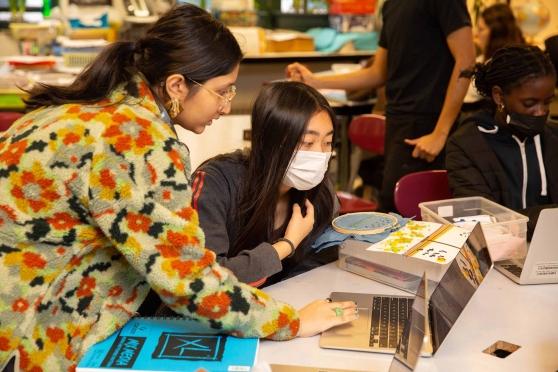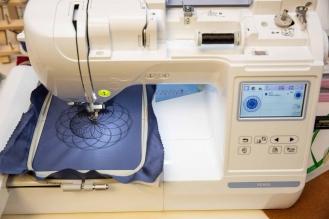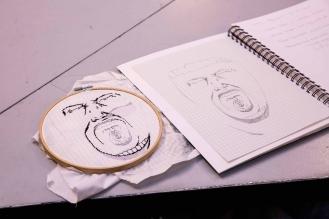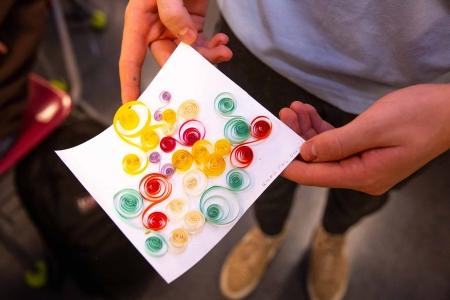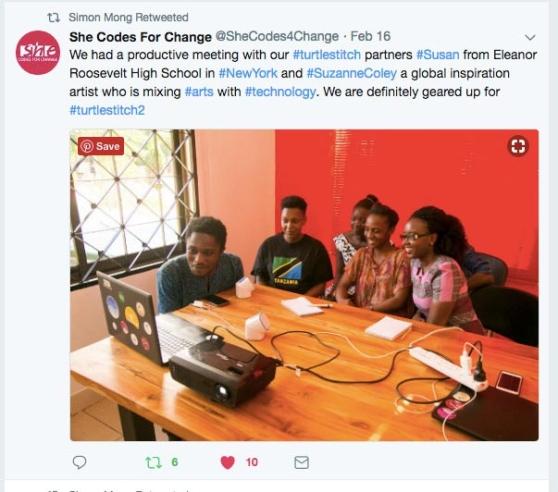Reaping what they sew
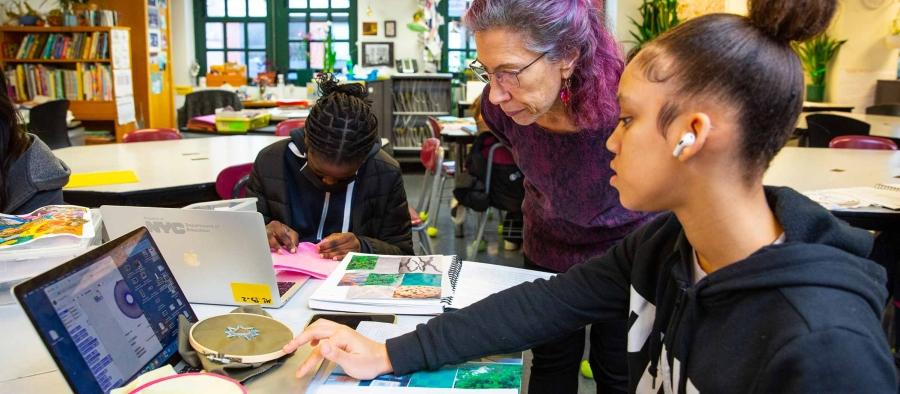
Susan Ettenheim (center) teaches students about coding patterns that can be sewn onto textiles.
Ivy, a 12th-grader at Eleanor Roosevelt HS on Manhattan’s Upper East Side, wanted to explore what she describes as “the cyclical pattern of emotions” through her art. She sketched a face whose mouth appeared wide open in a scream; inside the mouth was another screaming face.
After transferring her sketch onto water-soluble graph paper, Ivy painstakingly traced the penciled lines with a needle and thread. When she was finished stitching, she explained, the grid paper would dissolve in water, leaving behind a distinctive embroidered piece.
Ivy’s project is part of a unique new elective at Eleanor Roosevelt known as Patterns of the World. Designed by computer science teacher Susan Ettenheim, it allows students to apply computer science principles to the visual arts.
They learn how to code patterns for embroidery using TurtleStitch, an open-source programming language, meaning users are encouraged to access and modify the source code. They draw from their cultures for their designs, exploring and comparing patterns they’ve noticed in their homes and traditional clothes. Then they use digital sewing machines to produce their custom designs.
“It’s a beautiful opportunity to combine worlds,” Ettenheim says. “It’s human nature to make things and to make patterns inspired by the natural life around you. Everything in the world is a pattern, and when we think about a complex pattern with lots of lines overlaying each other — that’s what computer science is all about.”
Ettenheim, a professional artist, began teaching soon after Sept. 11, 2001 — “as many people changed their lives,” she says. She planned to spend just a few years as an educator. But while teaching a class on research methods, she became interested in Scratch, an educational programming language designed by the Massachusetts Institute of Technology Media Lab. At a Scratch conference in 2015, Ettenheim attended a workshop on TurtleStitch — and her own plans were soon stitched into place.
“As a young artist, I earned money doing custom embroidery,” Ettenheim says. “I realized I could combine computer science with my other passions, and I was so excited.”
Using funding from DonorsChoose and other sources, Ettenheim purchased a digital sewing machine, which contains software that allows users to transfer designs and data to and from a computer. Then she began using TurtleStitch to teach her students to code.
One former student became so interested in studying the programming language that Ettenheim created an independent elective for her. With Ettenheim’s guidance, her student launched an online blog in 2016 while exploring coding with TurtleStitch. She was soon creating video tutorials for the TurtleStitch website, and the program’s founders hired a professional graphic designer to turn her work into printable instruction cards for beginners.
“What she taught herself was amazing,” Ettenheim says. “That’s why I became a computer science teacher.”
Ettenheim taught AP computer science, using TurtleStitch and other programs to teach coding and programming. But it was a fortuitous visit to western Massachusetts that made her realize Patterns of the World was possible.
“There was a great segment on the local news station about a course in the Amherst school district studying textiles of the world,” she says. “I was listening and I thought, ‘We already do that!’ So I proposed to the principal that we make it a class.”
Chapter Leader Arturo Molina says he feels fortunate to work alongside Ettenheim.
“She’s so passionate about what she does, and she has a creative way of sharing it with students so it stays fresh and relevant,” he says. Molina, who teaches Spanish, recently teamed up with Ettenheim to introduce their classes virtually to students in Cuba. “She’s been the driving force behind our school’s technology department for many years, and with her expertise in art she’s managed to bring those two worlds together to the benefit of the kids.”
Ettenheim’s students have explored the Japanese tradition of sashiko, a type of stitching inspired by the custom of repairing clothes that became worn out in the fields, and have examined the history behind traditional European lace.
In the past, Ettenheim has even partnered with students in Tanzania who were learning how to code patterns as part of an effort to revive their traditional textile industry.
“My students would show them New York City through Zoom, and we would talk,” she says. “It’s a vehicle that teaches them computer science and coding and also creates economic advantage and revitalizes old traditions.”
The class has allowed students to expand complementary interests. A senior who plans to study data science in college has explored how to produce art through coding. A sophomore is learning to produce embroidery patterns for saris.
“As an art student, I wouldn’t normally be exposed to computer science,” notes Ivy. “My path has been doing what I’m used to, which is analog art. Now I’ve taken steps to introduce technology” like the dissolvable grid paper, a trick for keeping her drawing’s proportions intact as she transforms it into a cross-stitch.
Ettenheim sees Patterns of the World as an opportunity for students to examine not just art and computer science but their own cultural identities.
“We’ve been having so much fun comparing the patterns in our homes and our cultures,” she says. “Arts create opportunities for us to share with each other.”
